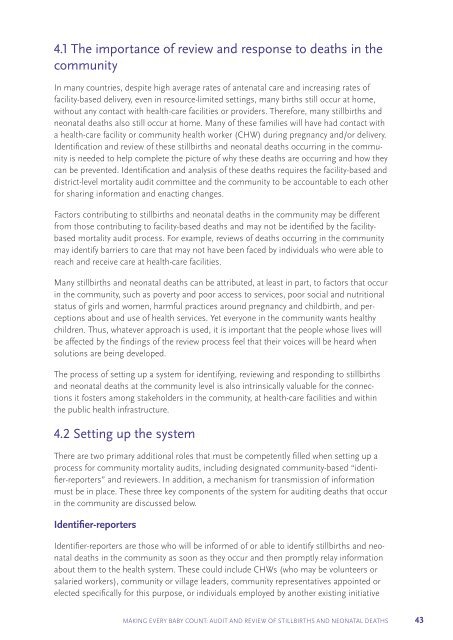Making Every Baby Count
9789241511223-eng
9789241511223-eng
You also want an ePaper? Increase the reach of your titles
YUMPU automatically turns print PDFs into web optimized ePapers that Google loves.
4.1 The importance of review and response to deaths in the<br />
community<br />
In many countries, despite high average rates of antenatal care and increasing rates of<br />
facility-based delivery, even in resource-limited settings, many births still occur at home,<br />
without any contact with health-care facilities or providers. Therefore, many stillbirths and<br />
neonatal deaths also still occur at home. Many of these families will have had contact with<br />
a health-care facility or community health worker (CHW) during pregnancy and/or delivery.<br />
Identification and review of these stillbirths and neonatal deaths occurring in the community<br />
is needed to help complete the picture of why these deaths are occurring and how they<br />
can be prevented. Identification and analysis of these deaths requires the facility-based and<br />
district-level mortality audit committee and the community to be accountable to each other<br />
for sharing information and enacting changes.<br />
Factors contributing to stillbirths and neonatal deaths in the community may be different<br />
from those contributing to facility-based deaths and may not be identified by the facilitybased<br />
mortality audit process. For example, reviews of deaths occurring in the community<br />
may identify barriers to care that may not have been faced by individuals who were able to<br />
reach and receive care at health-care facilities.<br />
Many stillbirths and neonatal deaths can be attributed, at least in part, to factors that occur<br />
in the community, such as poverty and poor access to services, poor social and nutritional<br />
status of girls and women, harmful practices around pregnancy and childbirth, and perceptions<br />
about and use of health services. Yet everyone in the community wants healthy<br />
children. Thus, whatever approach is used, it is important that the people whose lives will<br />
be affected by the findings of the review process feel that their voices will be heard when<br />
solutions are being developed.<br />
The process of setting up a system for identifying, reviewing and responding to stillbirths<br />
and neonatal deaths at the community level is also intrinsically valuable for the connections<br />
it fosters among stakeholders in the community, at health-care facilities and within<br />
the public health infrastructure.<br />
4.2 Setting up the system<br />
There are two primary additional roles that must be competently filled when setting up a<br />
process for community mortality audits, including designated community-based “identifier-reporters”<br />
and reviewers. In addition, a mechanism for transmission of information<br />
must be in place. These three key components of the system for auditing deaths that occur<br />
in the community are discussed below.<br />
Identifier-reporters<br />
Identifier-reporters are those who will be informed of or able to identify stillbirths and neonatal<br />
deaths in the community as soon as they occur and then promptly relay information<br />
about them to the health system. These could include CHWs (who may be volunteers or<br />
salaried workers), community or village leaders, community representatives appointed or<br />
elected specifically for this purpose, or individuals employed by another existing initiative<br />
MAKING EVERY BABY COUNT: AUDIT AND REVIEW OF STILLBIRTHS AND NEONATAL DEATHS<br />
43
















